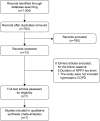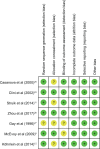Efficacy of long-term noninvasive positive pressure ventilation in stable hypercapnic COPD patients with respiratory failure: a meta-analysis of randomized controlled trials
- PMID: 29066879
- PMCID: PMC5644568
- DOI: 10.2147/COPD.S148422
Efficacy of long-term noninvasive positive pressure ventilation in stable hypercapnic COPD patients with respiratory failure: a meta-analysis of randomized controlled trials
Abstract
Introduction: The efficacy of long-term noninvasive positive pressure ventilation (NPPV) in stable hypercapnic COPD patients with respiratory failure remains unclear. The aim of this meta-analysis was to critically assess the efficacy of long-term NPPV on mortality, acute exacerbation, exercise capacity, symptoms and significant physiological parameters (lung function, respiratory muscle function and gas exchange).
Patients and methods: We performed an electronic literature search using the PubMed, Cochrane Library, Embase, OVID and Chinese Biomedical Literature Database in May 2017. Studies comparing treatment effects of NPPV with oxygen therapy in stable hypercapnic COPD patients with respiratory failure were conducted, and at least one of the following parameters were reviewed: frequency of acute exacerbation, mortality, lung function, respiratory muscle function, gas exchange, exercise capacity.
Results: Seven studies with 810 subjects were identified. The partial pressure of arterial carbon dioxide (PaCO2) significantly decreased in patients who received long-term NPPV (weighted mean difference [WMD] -3.73, 95% CI: -5.83 to -1.64, P=0.0005). No significant difference was found in mortality, partial pressure of arterial oxygen (PaO2), frequency of acute exacerbation, lung function, respiratory muscle function and exercise capacity. The subgroup analysis showed that NPPV significantly improved the survival of patients when it was targeted at greatly reducing hypercapnia (WMD 0.35, 95% CI: 0.19 to 0.64, P=0.0006).
Conclusion: The results indicate that long-term NPPV decreases the PaCO2 of stable hypercapnic COPD patients with respiratory failure and improves mortality with the aim of reducing PaCO2.
Keywords: COPD; gas change; meta-analysis; mortality; noninvasive positive pressure ventilation.
Conflict of interest statement
Disclosure The authors report no conflicts of interest in this work.
Figures





Similar articles
-
Home noninvasive positive pressure ventilation with built-in software in stable hypercapnic COPD: a short-term prospective, multicenter, randomized, controlled trial.Int J Chron Obstruct Pulmon Dis. 2017 Apr 27;12:1279-1286. doi: 10.2147/COPD.S127540. eCollection 2017. Int J Chron Obstruct Pulmon Dis. 2017. PMID: 28490871 Free PMC article. Clinical Trial.
-
High-intensity versus low-intensity noninvasive positive pressure ventilation in patients with acute exacerbation of chronic obstructive pulmonary disease (HAPPEN): study protocol for a multicenter randomized controlled trial.Trials. 2018 Nov 21;19(1):645. doi: 10.1186/s13063-018-2991-y. Trials. 2018. PMID: 30463622 Free PMC article.
-
Clinical impact of episodic nocturnal hypercapnia and its treatment with noninvasive positive pressure ventilation in patients with stable advanced COPD.Int J Chron Obstruct Pulmon Dis. 2018 Mar 6;13:843-853. doi: 10.2147/COPD.S153200. eCollection 2018. Int J Chron Obstruct Pulmon Dis. 2018. PMID: 29563784 Free PMC article.
-
Baseline Level and Reduction in PaCO2 are Associated with the Treatment Effect of Long-Term Home Noninvasive Positive Pressure Ventilation in Stable Hypercapnic Patients with COPD: A Systematic Review and Meta-Analysis of Randomized Controlled Trials.Int J Chron Obstruct Pulmon Dis. 2022 Apr 6;17:719-733. doi: 10.2147/COPD.S344962. eCollection 2022. Int J Chron Obstruct Pulmon Dis. 2022. PMID: 35418751 Free PMC article.
-
Why High-Intensity NPPV is Favourable to Low-Intensity NPPV: Clinical and Physiological Reasons.COPD. 2017 Aug;14(4):389-395. doi: 10.1080/15412555.2017.1318843. Epub 2017 May 11. COPD. 2017. PMID: 28494170 Review.
Cited by
-
Development and validation of a patient-reported outcome measure for patients with chronic respiratory failure: The CRF-PROM scale.Health Expect. 2021 Oct;24(5):1842-1858. doi: 10.1111/hex.13324. Epub 2021 Aug 1. Health Expect. 2021. PMID: 34337839 Free PMC article.
-
Risk factors analysis of noninvasive positive pressure ventilation in inpatients with overlapping syndrome of chronic obstructive pulmonary disease combined with obstructive sleep apnea.Ann Thorac Med. 2024 Jul-Sep;19(3):201-207. doi: 10.4103/atm.atm_305_23. Epub 2024 Jul 4. Ann Thorac Med. 2024. PMID: 39144532 Free PMC article.
-
Diagnosis and management of chronic obstructive pulmonary disease in Serbia: an expert group position statement.Int J Chron Obstruct Pulmon Dis. 2019 Sep 2;14:1993-2002. doi: 10.2147/COPD.S214690. eCollection 2019. Int J Chron Obstruct Pulmon Dis. 2019. PMID: 31564847 Free PMC article. Review.
-
Is positive airway pressure therapy underutilized in chronic obstructive pulmonary disease patients?Expert Rev Respir Med. 2019 May;13(5):407-415. doi: 10.1080/17476348.2019.1577732. Epub 2019 Feb 15. Expert Rev Respir Med. 2019. PMID: 30704303 Free PMC article. Review.
-
The Long-term Efficacy of Domiciliary Noninvasive Positive-Pressure Ventilation in Chronic Obstructive Pulmonary Disease: A Meta-Analysis of Randomized Controlled Trials.Tuberc Respir Dis (Seoul). 2022 Jan;85(1):47-55. doi: 10.4046/trd.2021.0062. Epub 2021 Nov 15. Tuberc Respir Dis (Seoul). 2022. PMID: 34775737 Free PMC article.
References
-
- Ojo O, Lagan AL, Rajendran V, et al. Pathological changes in the COPD lung mesenchyme – novel lessons learned from in vitro and in vivo studies. Pulm Pharmacol Ther. 2014;29(2):121–128. - PubMed
-
- Slenter RH, Sprooten RT, Kotz D, Wesseling G, Wouters EF, Rohde GG. Predictors of 1-year mortality at hospital admission for acute exacer-bations of chronic obstructive pulmonary disease. Respiration. 2013;85(1):15–26. - PubMed
-
- McEvoy RD, Pierce RJ, Hillman D, et al. Nocturnal non-invasive nasal ventilation in stable hypercapnic COPD: a randomised controlled trial. Thorax. 2009;64(7):561–566. - PubMed
Publication types
MeSH terms
LinkOut - more resources
Full Text Sources
Other Literature Sources
Medical

